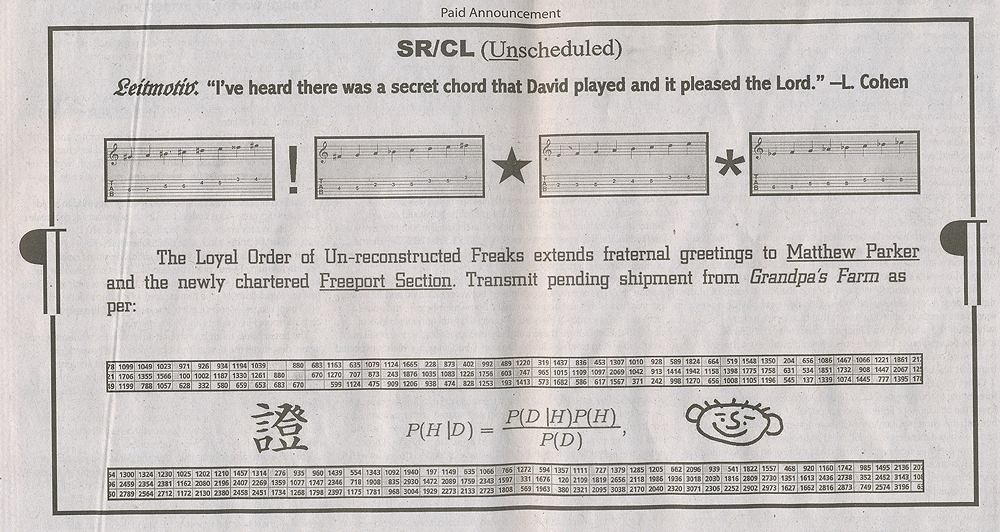
(here's a much larger version)
The leitmotiv is the first line of Leonard Cohen's "Hallelujah" released in 1984 on his album "Various Position", but Jeff Buckley's is widely considered to be the definitive recording. Recently Justin Timberlake performed it on the "Hope For Haiti" broadcast and I saw k.d. lang perform it during the opening or closing ceremonies of the Vancouver Olympics.
The formula given near the bottom is Bayes' formula for conditional probability. It's a sort of measure of the probability of a statement given our state of knowledge.
The music is written in an old "Catholic mode" of music. I get that from the fact that it their are double sharps and oddly placed sharp notes. Don
I'm fairly certain the music scores are guitar scales. This probably ties in with the leitmotiv, but I don't think it is important to the overall message.
Regarding the Freeport Section, if it involves any particular place, my guess would be Freeport, Maine because because of the reappearing New England and maritime themes. Also, I thought it might be helpful to cross-reference this mention of Grandpa's Farm with its appearance in other announcements: 9/29/88 - http://www.maydaymystery.org/mayday/texts/88-sept28.html 9/27/89 - http://www.maydaymystery.org/mayday/texts/89-sept27.html 9/26/02 - http://www.maydaymystery.org/mayday/texts/02-sept26.html 12/1/04 - http://www.maydaymystery.org/mayday/texts/04-dec1.html
Comments: The first scale is a mystery to me. The others are just the greek modes: 1: ? 2: F# super locrian (also called 'altered' or 'diminished whole-toned') 3: E Dorian 4: Eb mixolydian
The kanji/hanzi there on the lower left has the meaning of 'proof, evidence, testify, verify' etc.
The bands of numbers in a grid are from a paper atlas. That style is used to give a quick reference of distance between two cities. The blank spots are where a city self-references, so there is no distance. Given the large numbers, it's from an entire country, likely the US. Check out a basic road atlas, and a similar chart will be listed in either the very front or very back.
Perhaps they are using the guitar scales as a way to sign the four names that frequently appear on other Mayday puzzles, as they are put near symbols that also appear on other puzzles
